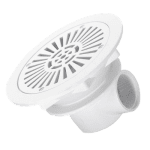Swimming pool tile cleaner
Swimming pool tile cleaners are essential products designed to effectively remove dirt, grime, scale, and other contaminants from the tiles surrounding and within the pool. These cleaners play a crucial role in maintaining the aesthetic appeal, hygiene, and longevity of swimming pool tiles. In this comprehensive description, we will explore the importance of tile cleaners, types of cleaners available, their ingredients and formulations, application methods, safety considerations, and best practices for using swimming pool tile cleaners.
Importance of Swimming Pool Tile Cleaners
Maintaining clean tiles is essential for several reasons:
- Aesthetic Appeal: Clean tiles enhance the visual appeal of the pool area, creating a sparkling and inviting environment for swimmers and guests.
- Hygiene: Regular cleaning helps prevent the buildup of algae, bacteria, and other microorganisms that can thrive in damp, moist environments, promoting a healthier swimming environment.
- Durability: Removing scale, mineral deposits, and stains from tiles helps extend their lifespan by preventing damage and deterioration over time.
- Safety: Clean tiles reduce the risk of slips and falls by eliminating slippery surfaces caused by algae or soap scum buildup.
Types of Swimming Pool Tile Cleaners
Swimming pool tile cleaners are available in various formulations to address different types of contaminants and tile materials:
- Acidic Cleaners: Acidic cleaners contain mild acids such as phosphoric acid or muriatic acid, which are effective for removing tough stains, scale, and calcium deposits from pool tiles. They are suitable for ceramic, porcelain, and glass tiles but should be used with caution to avoid damage to grout or sensitive stone tiles.
- Alkaline Cleaners: Alkaline cleaners are formulated with alkaline chemicals or detergents that help dissolve oils, grease, and organic stains from pool tiles. They are generally safer for grout and natural stone tiles but may require rinsing to remove residue.
- Enzymatic Cleaners: Enzymatic cleaners use enzymes to break down organic matter such as algae, oils, and body oils on pool tiles. They are biodegradable and environmentally friendly, making them a popular choice for regular maintenance.
- Oxidizing Cleaners: Oxidizing cleaners contain compounds like hydrogen peroxide or sodium percarbonate, which release oxygen to lift and remove stains, discoloration, and organic matter from tiles. They are effective for general cleaning and stain removal without the use of harsh chemicals.
- Specialty Cleaners: Specialty cleaners are formulated for specific purposes, such as removing metal stains, rust stains, or hard water deposits from pool tiles. These cleaners may contain specific chemicals or additives tailored to address particular types of stains or contaminants.
Ingredients and Formulations
The ingredients in swimming pool tile cleaners vary depending on their intended use and formulation:
- Surfactants: Surfactants help lift and suspend dirt, oils, and other contaminants from the tile surface for easy removal.
- Acids: Mild acids like phosphoric acid or citric acid dissolve mineral deposits, scale, and calcium buildup on pool tiles.
- Alkaline Agents: Alkaline agents such as sodium carbonate or sodium hydroxide help break down oils, grease, and organic matter.
- Enzymes: Enzymes break down organic matter such as algae, oils, and body oils into smaller molecules that can be easily rinsed away.
- Oxidizing Agents: Oxidizing agents like hydrogen peroxide or sodium percarbonate release oxygen to oxidize and lift stains and discoloration from pool tiles.
- Chelating Agents: Chelating agents bind to metal ions in water, preventing them from causing stains or discoloration on pool tiles.
Application Methods
Proper application of swimming pool tile cleaners ensures effective cleaning and minimizes potential damage to tiles or grout:
- Preparation: Before cleaning, remove any debris or loose dirt from the tile surface using a brush or soft cloth. This prevents scratching and helps the cleaner penetrate more effectively.
- Dilution: Follow manufacturer instructions for diluting the cleaner with water, if necessary, to achieve the recommended concentration for cleaning.
- Application: Apply the cleaner to the tile surface using a sponge, soft brush, or spray bottle. Work in small sections to ensure thorough coverage and contact time with the cleaner.
- Scrubbing: For stubborn stains or heavily soiled areas, gently scrub the tile surface using a soft brush or scrubbing pad to agitate the cleaner and loosen dirt or deposits.
- Rinsing: After allowing the cleaner to dwell according to manufacturer instructions, thoroughly rinse the tile surface with clean water to remove residue and prevent chemical buildup.
- Repeat if Necessary: For persistent stains or heavily soiled areas, repeat the cleaning process as needed until the desired level of cleanliness is achieved.
Safety Considerations
When using swimming pool tile cleaners, safety precautions are essential to protect both users and the pool environment:
- Personal Protective Equipment (PPE): Wear gloves, eye protection, and protective clothing to minimize exposure to chemicals and potential skin irritation.
- Ventilation: Ensure adequate ventilation when using cleaners indoors or in enclosed pool areas to prevent inhalation of fumes or vapors.
- Compatibility: Check compatibility with tile materials, grout, and pool surfaces to avoid damage or discoloration. Test cleaners on a small, inconspicuous area before full application.
- Storage: Store cleaners in their original containers in a cool, dry place away from children and pets, following manufacturer guidelines for shelf life and disposal.
Best Practices for Using Swimming Pool Tile Cleaners
To maximize the effectiveness and safety of swimming pool tile cleaners, adhere to these best practices:
- Regular Maintenance: Implement a regular cleaning schedule to prevent buildup of dirt, oils, and stains on pool tiles.
- Prompt Cleaning: Address spills, stains, or debris on tiles promptly to prevent them from becoming more challenging to clean over time.
- Follow Manufacturer Instructions: Always read and follow manufacturer instructions for proper dilution, application, contact time, and rinsing procedures.
- Avoid Overuse: Use cleaners in moderation to avoid chemical buildup or damage to tiles and grout.
- Post-Cleaning Inspection: Inspect tiles after cleaning to ensure all residues are removed and tiles are free from streaks or discoloration.
Environmental Considerations
Choose environmentally friendly cleaners whenever possible, such as enzymatic or biodegradable formulations, to minimize impact on aquatic ecosystems and surrounding environments.
Maintaining clean pool tiles is essential for both the aesthetics and hygiene of a swimming pool. Over time, pool tiles can accumulate hard water stains, algae, mineral deposits, and grime that not only detract from the pool’s appearance but can also create slippery or hazardous surfaces. Fortunately, a variety of swimming pool tile cleaners are available to help remove these build-ups effectively. Here’s a detailed guide to swimming pool tile cleaners, including types, application methods, and best practices for keeping your pool tiles in pristine condition.
1. Common Problems with Pool Tiles
Understanding the issues that can affect pool tiles helps in choosing the right cleaning approach. Common problems include:
- Calcium Deposits: As pool water evaporates, it can leave behind calcium deposits, which appear as white or grayish crusts, often on the waterline tiles.
- Algae and Mold: Algae, mold, and mildew can grow on tiles, particularly in warm, humid conditions or pools with imbalanced water chemistry.
- Mineral Stains: Metals and minerals from hard water can lead to stains that discolor tiles, particularly in pools that use well water.
- Grease and Oils: Body oils, sunscreen, and other organic residues can build up on tiles, leaving a slippery film that attracts more dirt and grime.
2. Types of Swimming Pool Tile Cleaners
There are several types of pool tile cleaners available, each suited for different cleaning needs. Here are some of the most common ones:
a) Acid-Based Cleaners
Acid-based cleaners are highly effective for removing stubborn calcium deposits and mineral stains on pool tiles. These cleaners dissolve hard deposits and are particularly useful for tough buildups. However, acid-based cleaners should be handled carefully due to their strong chemical composition. It’s essential to follow the instructions and wear protective gear.
b) Enzyme-Based Cleaners
Enzyme-based cleaners are eco-friendly options that are effective for removing organic residues such as oils, grease, and body lotion. They work by breaking down the organic compounds, making it easier to wipe the tiles clean. Enzyme cleaners are often safe for both the environment and the user, making them ideal for regular use.
c) pH-Neutral Cleaners
For routine cleaning, pH-neutral cleaners are gentle on tiles and pool surfaces while effectively removing dirt, light oils, and mild stains. These cleaners do not alter the pool’s water chemistry, so they are safe to use frequently and don’t require draining the pool or significant rinsing.
d) Pumice Stones and Tile Brushes
In addition to liquid cleaners, pumice stones and specialized tile brushes are used as physical tools for cleaning pool tiles. Pumice stones are effective for scrubbing away tough stains and calcium deposits without damaging the tiles. Tile brushes, particularly those with nylon bristles, can also remove algae and grime without scratching the tile surface.
e) Vinegar and Baking Soda
For those who prefer natural cleaning methods, a mixture of vinegar and baking soda can be used to clean pool tiles. Vinegar works as a mild acid to dissolve calcium deposits and mineral stains, while baking soda acts as a gentle abrasive to scrub the surface. This is an affordable and eco-friendly option for general cleaning.
3. Choosing the Right Tile Cleaner for Your Pool
The best tile cleaner for your pool depends on the type and extent of the buildup on your tiles. Here are some guidelines to help you choose:
- For Heavy Calcium Deposits: Acid-based cleaners or pumice stones are ideal for scrubbing away tough calcium deposits.
- For Organic Residues and Grease: Enzyme-based cleaners work well for removing oils, sunscreen residue, and organic films.
- For Routine Maintenance: pH-neutral cleaners or mild natural solutions (like vinegar and baking soda) are suitable for regular tile maintenance.
- For Sensitive Surfaces: If you have delicate tiles, opt for enzyme cleaners or pH-neutral cleaners to avoid potential damage.
4. How to Clean Swimming Pool Tiles
Proper application of the tile cleaner is essential for effective results. Here’s a step-by-step guide to cleaning pool tiles:
- Prepare the Area: Lower the pool water level if necessary to expose the dirty tiles fully. This is especially helpful for tackling buildup at the waterline.
- Choose the Right Cleaner: Select a cleaner based on the type of buildup (calcium, algae, etc.) and carefully read the instructions on the product label.
- Apply the Cleaner: Apply the cleaner to the tiles using a spray bottle or sponge. For acid-based cleaners, wear gloves and avoid contact with skin. Allow the cleaner to sit for a few minutes to break down the buildup.
- Scrub the Tiles: Use a tile brush or pumice stone to scrub the tiles in a circular motion, focusing on areas with more deposits or stains. Be careful not to scratch delicate tiles.
- Rinse Thoroughly: Rinse the tiles thoroughly to remove any residue from the cleaner. Make sure no cleaner is left behind, as it could affect the pool’s water chemistry.
- Check and Balance Pool Chemistry: After cleaning, it’s essential to test the pool’s pH and alkalinity levels to ensure they remain balanced, as some cleaners can affect water chemistry.
5. Tips for Maintaining Clean Pool Tiles
Consistent maintenance helps prevent severe buildup on pool tiles. Here are a few tips to keep your tiles looking new:
- Regular Brushing: Brush the tiles at least once a week to prevent the formation of algae and grime. A nylon bristle brush is effective for light scrubbing.
- Use a Pool Cover: Covering your pool when not in use reduces the amount of debris, dust, and dirt that settles on the waterline, helping to keep tiles clean.
- Monitor Water Chemistry: Keeping your pool’s pH and alkalinity balanced reduces the chances of mineral deposits forming on tiles.
- Invest in Automatic Pool Cleaners: Robotic pool cleaners that can scrub tiles and waterlines can save time and effort, especially for larger pools.
6. When to Call a Professional
For severe buildup, particularly on large pools or commercial facilities, it may be best to call a professional pool cleaning service. Professionals have access to specialized tools, cleaners, and techniques like bead blasting, which uses fine glass beads or other media to remove hard deposits without damaging tiles.
Conclusion
Swimming pool tile cleaners are essential for maintaining the cleanliness, hygiene, and aesthetic appeal of pool tiles. By selecting the appropriate cleaner based on tile type, contaminants, and cleaning objectives, pool owners can ensure tiles remain pristine and durable over time. Adhering to proper application methods, safety precautions, and best practices enhances the effectiveness of cleaners while minimizing potential risks to users and the environment. Regular cleaning and maintenance not only enhance the visual appeal of swimming pools but also contribute to a safer and more enjoyable swimming experience for all users.


















